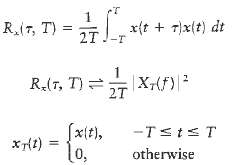Question: In this computer experiment we study the statistical characteristics of a random process X (t) defined by X (t) = A cos (2?? c t
In this computer experiment we study the statistical characteristics of a random process X (t) defined by X (t) = A cos (2??ct + ?) + W (t). Where the phase ? of the sinusoidal component is a uniformly distributed random variable over the interval [-?, ?], and W (t) is a white Guassian noise component of zero mean and power spectral density N0/2. The two components of X (t) are statistically independent; hence the autocorrelation function of X (t) is RX (?) = A2/2 cos (2??c?) + N0/2 ? (?). This equation shows that foe | ? | > 0 the autocorrelation function RX (?) has the same sinusoidal waveform as the signal component of X (t). The purpose of this computer experiment is to perform the computation of RX (?) using two different methods.
(a) Ensemble averaging. Generate M = 50 randomly picked realizations of the process X (t). Hence compute the product x(t + ?) x (t) fir the M realizations of X (t), and there by compute the average of these computations over M. Repeat this sequence of computations for different values of ?.
(b) Time averaging. Compute the time-averaged autocorrelation function, where x (t) is a particular realization of X (t), and 2T is the total observation interval. For this computation, use the Fourier-transform pair, where | XT (?) | 2 /2T is the period-gram of the process X (t). Specifically, compute the Fourier transform XT (?) of the time-windowed function. Hence compute the inverse Fourier transform | XT (?) | 2 / 2T. Compare the result of your computation of RX (?) using two approaches.

R7, T) = x{t + r)x(t) dt 27. -T X,(f) R,(r, T)= Sx(t), xr{1) 0, -TstsT %3D otherwise
Step by Step Solution
3.34 Rating (160 Votes )
There are 3 Steps involved in it
Autocorrelation of a Sinusoidal Wave Plus White Gaussian Noise In this computer experiment we study the statistical characterization of a random process X1 consisting of a sinusoidal wave component Ac... View full answer

Get step-by-step solutions from verified subject matter experts
Document Format (1 attachment)
19-E-T-E-C-S (32).docx
120 KBs Word File


